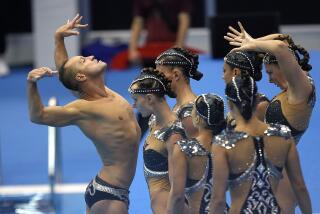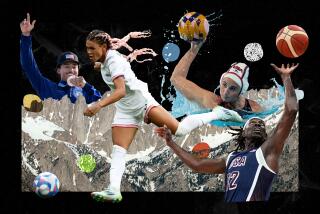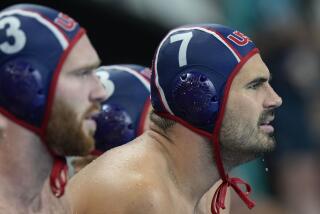A Different Long Course : Polish Swimmers Learn New Lifestyle in Mission Viejo
- Share via
MISSION VIEJO — Marcin Malinski, Konrad Galka and Adam Grodzki have come a long way to study Polish history. Their research is aquatic not academic, however, and the lessons are learned in a pool, not a classroom.
Each is hoping to make history repeat itself by following in the wake of former students from their homeland--such as former world record-holder Artur Wojdat--who have traveled halfway around the globe to go through the pain and the glory that can result from what Mission Viejo Nadadores Coach Terry Stoddard likes to call “high-volume training.”
Stoddard makes it sound as if they’re just foreign exchange students with wet hair. He says they’re here to “go to school, learn English, experience the culture and be part of the Nadadores.”
They say they’ve come to learn how to swim fast.
“This is a very big chance,” said Grodzki, a 16-year-old from Warsaw. “To be the very best, you must train hard. And even if the workout is very hard and you can do it, you feel good after.”
There are no free rides for gold medalists in Poland these days, so these three have a goal that most top young American swimmers take for granted: the opportunity to attend college in the United States.
“American colleges have a kind of quality that isn’t in Poland after high school,” Grodzki said. “UCLA, Yale, even in Poland, I know these names. I don’t think any Americans could say the name of a Polish college.”
In 1985, Wojdat and Wojciech Wyzga were the first of 18 Poles who have since made the pilgrimage to Mission Viejo. Wojdat, who won a bronze medal in the 400-meter freestyle in the Seoul Olympics, will graduate from Iowa this year. Wyzga and Mariusz Podkoscielny (Nadadores’ Class of ‘87) are swimming at Arizona. Tomasz Gawronski (Iowa) and Marek Izydorczyk (Hawaii), who trained with the Nadadores in ‘86, are attending school on swim scholarships. Rafel Szukala (‘87) will attend Iowa in the fall.
Malinski, an 18-year-old individual medley swimmer from Gdynia, spent most of last year training in Mission Viejo. When he was asked by the Polish Swimming Federation if he wanted to return, he didn’t hesitate.
“I said, ‘Yes, yes,’ because I made very good times last year,” he said. “I was very, very homesick last year, but I thought I must come back again. Now this is like home for me. Coach Terry is like a father. This is a very big chance because I swim for a scholarship.”
Alex Kuryllo, a Villa Park developer who fought in the Polish Army during World War II, was going to play host to 155 Polish athletes when they came to the Southland for the 1984 Summer Olympics.
“Then Russia said, ‘Nyet!’ and they never came,” he said.
Kuryllo didn’t give up his quest to help the Polish Olympic cause, however, and he formed the Polish-American Sports Foundation, the group that raises the $700 per month, per swimmer that it takes to fund the program that has given Malinski his chance to swim for a scholarship.
“We want to get them scholarships at U.S. schools,” Kuryllo said, “but they must be excellent swimmer to get that. The ones who have come here have been very successful because of the discipline here. We take them to church almost every Sunday. They must do their schoolwork. And they must swim more kilometers each day than they are used to.”
The commitment necessary to train at this level has made for a love-hate relationship between many a swimmer and coach. But often they develop a bond that only people who wear Speedos at 5 a.m. in December can understand.
“We were excited and surprised when they changed their policy and sent Marcin back,” Stoddard said. “It had been primarily a one-year student-athlete exchange program, but that’s always gone against my nature.
“Once you’re a Nadadore, you’re always a Nadadore. I don’t coach people for six months or a year and feel good about it. I mean I feel good about these swimmers as people. But it hurts like blazes when they go back. There’s a piece of me that goes with every swimmer that leaves here, if they’re an American or not.”
Like his predecessor, Mark Schubert, Stoddard has heard his share of criticism for training foreign athletes to take medals and scholarships away from U.S. swimmers. The Nadadores, he says, were set up to be open to anyone who can swim fast enough and foot the bill.
“We do have a housing program,” he said, “and we’re very lucky to have 25 folks in the community who are gracious enough to open their homes. The swimmers are placed on ability, not nationality. First, they have to have the desire to train at our level. Second, they have to have the time standards. We train athletes.
“As far as I’m concerned, it’s really an INS problem. If they are going to allow these people into the country, then they should have the right to choose whatever they want to do.”
Coming to America means speaking English. Almost all the time. You just don’t run into a lot of Southern Californians well-versed in Polish. Malinski, Galka and Grodzki all attend Mission Viejo High School and their command of English is essential to their academic and social progress.
Galka, a 17-year-old butterfly specialist from Krakow, says the language barrier is “not a very big problem, but not a very small problem.”
Some languages are universal, though, and some things never change. The look on the face of a guy who just finished sloshing through his second five-mile workout of the day is universal. And guys who swim 10 miles a day always remember every meter.
Ask Galka the biggest difference between the U.S. and Poland and he says: “Biggest difference is training. At home we swim 10-11 kilometers a day. Here we swim 15-16. It is very much for me.”
But all three seem to agree that more is proving to be better.
“This is very good for me,” Malinski said. “This is what I need.”
It’s all about shaving a few seconds and all three have shown improvement.
Malinski has gone from a promising junior to the 26th-ranked 400-meter individual medley swimmer in the world this year, and he’s yet to rest for a meet. He has already qualified for the European Championships.
“He came back much more mature,” Stoddard said, “especially in terms of his attitude and work ethic. He was very playful last year, but he’s working very hard this year.”
Galka and Grodzki have been in Mission Viejo only a few months--they arrived Nov. 5--but both have made significant strides already.
“Konrad has already made senior national qualifying times (in the 100- and 200-meter butterfly events) and he’s just short of making it in the 400 freestyle,” Stoddard said. “And when you can make those time standards without resting, that’s a pretty good indication you can score at nationals.
“When I asked for a description of these boys before they came, everyone I talked to said Adam could do ‘everything.’ I asked, ‘What’s everything?’ It turns out literally every event. His worst event is the 100 backstroke and he does that pretty well. His best event seems to be the 200 breaststroke, but he’s just shy of making senior national time in the 400 free and that’s really unusual.”
Their focus is on the pool, but these are three teen-agers who have come to believe they are embarking on a great adventure of opportunity.
“I want to swim fast,” Malinski said, “but I also want to learn the language and learn about different culture.”
Grodzki nodded, smiled and asked his friend if it was OK to interrupt.
“You see, America is like a symbol to everyone,” he said. “It’s a chance to see this different lifestyle here.”
Malinski: “And it is very different. We always think here you have--how do you say--the easy life? Maybe relaxed is the word. In Poland, everyone always has something to worry about.”
So, is life here as carefree as he thought it would be?
“Yeah, I think so,” he said.
More to Read
Go beyond the scoreboard
Get the latest on L.A.'s teams in the daily Sports Report newsletter.
You may occasionally receive promotional content from the Los Angeles Times.






